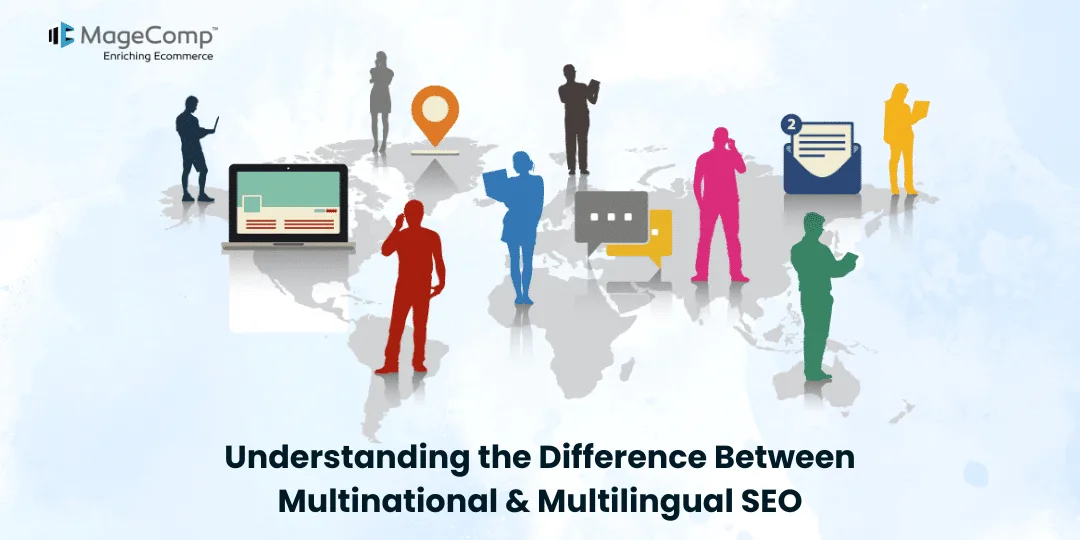Business expansion beyond local boundaries is the dream of almost every business owner. The advancing technology of the internet has made the path to achieving this dream even more accessible than ever.
However, every coin has two sides, and with the decision to enter foreign markets comes the need to translate the website according to the area. For this, it requires a comprehensive understanding of both multinational and multilingual SEO.
While these terms are often used interchangeably, they have distinct differences that can significantly impact your global marketing strategy. In this informative article, we will learn about the difference between multinational and multilingual SEO.
Multinational and Multilingual Websites
Websites that are created targeting audience groups across multiple countries are known as multinational websites or global websites.
Multinational websites may and may not be multilingual every time, depending on their targeted countries.
For instance, when targeting English-speaking audiences in the United States, United Kingdom, Australia, and Ireland, you can opt for either a single English-language website catering to all four markets or multiple English local market websites with tailored merchandising and pricing offers for each specific market.
On the other hand, multilingual websites are built with multiple websites but may or may not target multiple countries.
For instance, your target audience is in Canada, where many people speak French and English. In that case, you need to build a multilingual website that supports both languages.
Similarly, if USA customers are your target audience, your website must be in languages like English and Spanish.
What is Multinational SEO?
When it comes to multinational or international SEO, the focus is on optimizing websites for multiple countries to attract traffic and achieve high rankings.
One of the main challenges for multinational sites is ensuring proper indexing and ranking, as well as making sure that the correct country-specific site appears in search results.
If you have multiple websites in the same language, such as Spanish, it’s essential to take specific steps to inform search engines about which site is intended for which country.
Hence, when creating websites for different countries, it’s important to optimize and localize them individually. If multiple sites in the same language are not properly optimized and localized, search engines might treat them as duplicates and exclude some of them.
In cases where each country has its own domain, it’s necessary to optimize separate websites while taking into account the entire infrastructure.
Key Components
Country-specific domains: Using country code top-level domains (ccTLDs) like .uk for the United Kingdom or .de for Germany can significantly boost a site’s relevance in specific countries. These domains signal to search engines that the content is specifically intended for users in those regions.
- Server Location – Hosting the website on servers located in the target country can improve load times and search engine rankings. Faster load times are crucial for user experience and can positively impact SEO rankings.
- Local Backlinks – Building backlinks from local websites and directories helps improve local SEO performance. Local backlinks enhance a site’s authority and relevance within a specific country.
- Geo-targeting in Google Search Console – Setting up geo-targeting preferences in Google Search Console to specify the target country for each web page. This tool allows businesses to explicitly tell Google which country a particular webpage is intended for, improving its visibility in local searches.
Benefits
- Enhanced Local Relevance – By optimizing content to cater to specific countries, businesses can appear more relevant to local audiences. This relevance can lead to higher engagement rates and better conversion rates.
- Improved SERP Rankings – Country-specific strategies can help businesses rank higher in local search results. Higher rankings increase visibility and drive more organic traffic.
- Better User Experience – Localized content and faster load times contribute to a superior user experience, which can lead to increased site engagement and lower bounce rates.
What is Multilingual SEO?
As the name suggests, multilingual refers to a website with content that can be translated into different languages according to the country and its language. Because of this, content duplication is not such a big concern.
The only factors that matter with multilingual SEO are that the website’s content is translated correctly into the country’s native language without hindering the original meaning of the content, which the admin wants to convey, and that it aligns with the user’s search intent.
Many websites use the same domain for different language versions, organizing them under separate language folders to simplify management.
However, having separate sites for different languages can also present challenges, especially when trying to reach audiences in multiple countries. Search engines may have difficulty identifying the intended target audience for each language-specific site.
Additionally, when content is localized, essential elements may be overlooked, leading to issues such as missing popular phrases or well-optimized content clusters, which can negatively impact the site’s performance.
Key Components
- Language-specific URLs – Using separate URLs for different languages (e.g., example.com/en/ for English and example.com/es/ for Spanish) helps search engines index and rank the content appropriately. These URLs make it clear which content is intended for which language speakers.
- Hreflang Tags – Implementing hreflang tags to indicate the language and regional targeting of a webpage, helping search engines serve the correct language version to users. Hreflang tags prevent duplicate content issues by clarifying the relationship between different language versions of the same content.
- High-Quality Translation – Ensuring content is accurately translated and culturally relevant, avoiding machine translations that can lead to misunderstandings. Professional translations ensure that nuances and local idioms are correctly captured.
- Language-Specific Keywords – Conduct keyword research for each target language to optimize content for local search behavior and terminology. This step is crucial as search behavior can vary significantly across different languages.
Benefits
- Broader Audience Reach – Multilingual SEO enables businesses to reach non-native speakers, expanding their potential customer base. This extended reach can lead to increased brand awareness and market penetration.
- Increased Engagement – Users are more likely to engage with content that is in their native language. Engagement metrics such as time on site and pages per session can improve significantly.
- Improved Conversion Rates – Providing content in multiple languages can lead to higher conversion rates as users find the information more accessible and trustworthy. Clear and understandable content reduces friction in the conversion process.
Conclusion
Understanding the difference between Multinational and Multilingual SEO is crucial for businesses looking to expand their global reach. While both strategies aim to optimize a website for better search engine performance, they do so in distinct ways.
Multinational SEO focuses on geographic targeting, while Multilingual SEO addresses language differences. By effectively combining both strategies, businesses can ensure they are visible, relevant, and accessible to a diverse global audience, ultimately driving more traffic, engagement, and conversions.
In an increasingly interconnected world, mastering these SEO strategies is not just beneficial but essential for any business aiming to succeed on the global stage.
Whether you are targeting new markets or expanding your language offerings, understanding and implementing these SEO techniques will help you stay ahead in the competitive digital landscape.
By focusing on both geographic and linguistic optimization, businesses can create a comprehensive and effective global SEO strategy that meets the needs of a diverse audience.













